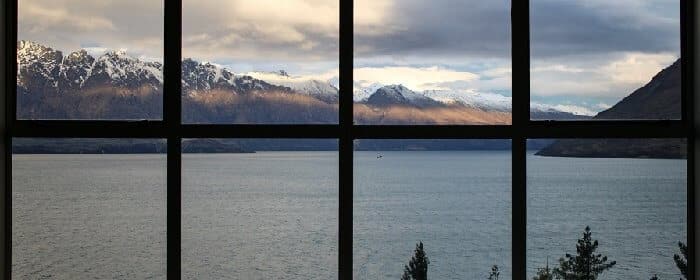A Look at the Differences between These Similar Window Styles
With so many various window styles to choose from in today’s market, it can be a bit overwhelming to narrow down your search.
Whether you’re getting window replacement or you’re installing new residential windows, there are some things to consider when deciding between fixed and picture windows.
While fixed and picture windows are similar in many ways, they are not the exact same.
So to help you find the best options when window shopping, here’s a look at the fundamentals of fixed and picture windows.
Picture Windows
Picture windows are large, fixed (stationary) windows with low-profile frames to maximize the glass surface and your view of the outdoors. Unobstructed views are the defining feature of picture windows. And they are often used as decorative windows and focal points in living rooms and bedrooms.
Configurations
Picture windows can be installed on their own or custom designed to match and combine with other windows.
A wide picture window is usually installed between two smaller windows. These two flanking windows can be fixed, double-hung, sliding, casement, or awning windows.
Bay windows use a picture window in the middle that is flanked by two operable windows to increase the view and allow for ventilation.
You can also pair a door with a picture window in your entryway for extra light, especially if the door is lacking glass.
Window Placement
Picture windows can be placed to showcase and enhance a beautiful view of the outdoors, e.g., of your backyard, and to increase the amount of natural light in your home.
Popular placement options for picture windows include:
[su_list icon=”icon: chevron-right” icon_color=”#EC3826″]
- Above the kitchen sink
- In the dining room
- In the living room
- In the master bedroom
[/su_list]
Window Size
Picture windows are available in a variety of sizes and can be custom designed to suit your needs.
The largest picture window styles tend to reach 9 feet wide by 8 feet tall.
When combining a picture window with two flanking casement or awning windows, consider a size between 20 to 24 inches wide and 24 to 48 inches tall.
If you plan to combine a picture window with two flanking single-or double-hung windows, a suitable size range is 28 to 36 inches wide and 52 to 74 inches tall.
Benefits
The many benefits of picture windows include:
[su_list icon=”icon: chevron-right” icon_color=”#EC3826″]
- Expansive views
- The aesthetic of your home is enhanced
- They showcase a beautiful, unobstructed view that increases the sightline of your home, making your house appear larger
- They increase the amount of natural light indoors, making rooms appear brighter
[/su_list]
Drawbacks
Here are the few drawbacks of picture windows:
[su_list icon=”icon: chevron-right” icon_color=”#EC3826″]
- They are inoperable
- Lack of ventilation—but this can be remedied with a combination of operable flanking windows
- You cannot clean the exterior side from indoors
[/su_list]
Fixed Windows
A fixed window is set in the closed position. It is stationary and cannot open (non-operational). Fixed windows often look like picture windows except that they have larger and thicker frames.
Their larger and thicker frames allow them to match the sightlines of neighbouring operational windows. And their exposed frames also make them appear bolder and more defined.
Due to their larger frames, their glass area isn’t as expansive as picture windows. But fixed windows still let in more light and views compared to other window styles.
Configurations
Fixed windows come in many shapes and sizes and can be installed on their own or in combination with other window styles, such as casement, awning, and double-hung windows. They can also be installed above doors (e.g. transom windows) and in tall hallways.
Here are examples of the many shapes of fixed windows:
[su_list icon=”icon: chevron-right” icon_color=”#EC3826″]
- Round
- Circle top
- Oval
- Octagon
- Triangle
- Trapezoid
[/su_list]
Window Placement
Fixed windows look good in any room, but they are most often used in living rooms, dining rooms, family rooms, bathrooms, basements, nurseries, tall hallways, and rooms with vaulted ceilings.
Window Size
Fixed windows come in various sizes, from small to large. However, if you need a fixed window that is larger than 84 inches in either height or width, a direct set picture window is your best option.
Benefits
Here are the many benefits of fixed windows:
[su_list icon=”icon: chevron-right” icon_color=”#EC3826″]
- Natural light
- Unobstructed views
- Low-maintenance—no need to replace weather-stripping or hardware
- Easy to clean
- No drafts
- Insulation from cold air and pollen
- Energy-efficient
- Cost-effective—often the least expensive type of window
- Solar heat
- Secure
- Safer on floors above ground level
- Bold, defined frames are ideal for adding architectural interest to modern and contemporary homes
[/su_list]
Drawbacks
Here are the few drawbacks of fixed windows:
[su_list icon=”icon: chevron-right” icon_color=”#EC3826″]
- Inoperable
- Lack of ventilation
- Cannot clean the exterior side from indoors
- Cannot be used as a fire escape route
[/su_list]
How Do They Measure Up?
A picture window is a type of fixed window, as are architectural windows. Picture windows and fixed windows share all the same characteristics along with the same differences when compared to operable windows.
However, a fixed window has a thicker frame than a picture window frame, so it is better insulated and blends in better with operable windows that are next to it, allowing for more symmetry. A fixed window often has the same size sash as a casement or awning window, so grilles and sightlines can line up.
But if you want to enhance your view of the outdoors, you may opt for the larger unobstructed view of a picture window.
While both window styles provide the ultimate views, your final decision will depend on the frame, size, location of the window, and your window configurations. For more help finding the best window style for you and your home, consult with the window experts.


